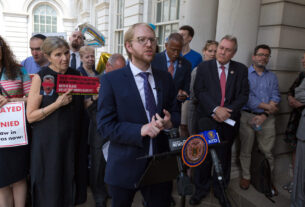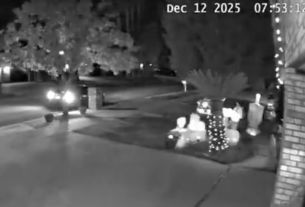THIS WEEK, President Joe Biden met with leaders from five major American Jewish organizations in response to a letter expressing concerns about a “surge in antisemitic attacks,” which the groups connect to popular discourse and protest surrounding Israel’s military campaign in Gaza. Republican Senators Tom Cotton and Mitch McConnell announced their intention to introduce a bill combatting antisemitic hate crimes. On social media, antisemitism became a trending topic, with users posting blue squares on their Instagram feeds in support of Jews.
Most of the news stories on recent antisemitism cite the Anti-Defamation League (ADL), which, in a May 20th press release, reported an “uptick in antisemitic incidents linked to recent Mideast violence.” But what does an “uptick in antisemitic incidents” really mean? How do we measure a “surge”? These past few months, I’ve been immersed in researching hate crimes and hate crime legislation in the United States, and I’ve learned that it is notoriously challenging to actually identify a spike in incidents. As ProPublica has meticulously documented, the US government’s methodology for reporting on hate crimes is incomplete and inaccurate, as it relies on reports from local police departments, many of which opt out of providing such data. (The majority of departments that do participate in the FBI’s program to track hate crimes typically report zero incidents—evidence that police do not view documenting hate crimes as a priority.) Private advocacy organizations like the ADL that track hate crimes against specific communities use a broad range of criteria and collection methods, making it difficult to get a full picture. All in all, in moments of greater vigilance, like this week, experts say it’s possible that statistics like the ADL’s are recording an uptick in attention to a particular group, rather than an upswing in violence: When a certain topic is prominent in the media, victims may be more likely to report or share information about violent incidents, and advocacy organizations and law enforcement may be more motivated to track those reports, skewing the data. “We’re actually measuring spikes in media attention to these crimes more than we’re actually measuring crimes,” Mike German, a fellow at the liberal think tank Brennan Center for Justice, with expertise in hate crimes and domestic terrorism, told me recently. “Law enforcement responds to the political attention of the day rather than objective collection and enforcement on a continuous basis.”
As evidence of the “uptick” in antisemitism, the ADL says it has documented more than 17,000 tweets containing variations of the phrase “Hitler was right” between May 7th and May 14th, the week when violence broke out in Israel/Palestine. The organization also said it had received 193 reports of “possible antisemitic incidents . . . in the week after the crisis began, up from 131 the previous week.” But a closer look at these statements yields a number of follow-up questions. Online abuse by purported neo-Nazis or those adopting their rhetoric is unfortunately common; has the ADL tracked tweets glorifying Hitler for other weeks, in order to provide a baseline for comparison to the number of tweets it found in recent weeks? And had the organization yet reviewed reports of the 193 “possible incidents” to determine their legitimacy? What kinds of incidents were they? Assault? Harassment? Vandalism? How did the organization decide when to add an incident to its “tracker of antisemitic incidents,” which does not yet contain 193 reports for that week? Meanwhile, a May 24th ADL blog post, cited in The New York Times, used an entirely different set of numbers, reporting an increase from 68 the week before Israel and Hamas began exchanging fire to an eventual 124 the week of May 17th. What accounts for these competing datasets? The ADL did not respond to my requests for comment.
In the absence of further insight into the ADL’s methods, I did my own analysis of the incidents it has added to the aforementioned tracker. The tracker, which the organization notes is “nonexhaustive,” draws from a variety of sources, including news articles as well as direct reports to the ADL. While the incidents are aggregated in a single list, they vary widely by type, including everything from anti-Zionist protest chants to vitriolic Facebook comments to swastika graffiti to assault. I analyzed the 43 incidents in the tracker that occurred between May 7th, when Israeli police fired flashbangs and rubber bullets at Palestinian worshippers in the Al Aqsa compound in Jersualem, and May 24th. (Some incidents may since have been added retroactively, since the ADL updates this list continuously.) Of those 43 incidents, seven were cases of violent assault related to Israel/Palestine, including several that have circulated on social media, such as a reported attack on Jews dining at a kosher restaurant in Los Angeles by a group of men who had driven by waving Palestinian flags, and an incident in New York City’s Times Square in which a group of men holding Palestinian flags appeared to beat a Jewish man with a crutch. At least one of the listed incidents, in which a Jewish couple at a Westlake, Ohio pro-Palestine rally were allegedly attacked by protestors, has been disputed online: A Twitter user said they attended the rally in question and that the couple actually showed up to attack protestors with a flagpole. In addition to those seven incidents, one incident of violent assault had no documented connection to the situation in Israel/Palestine.
These violent occurrences are presented in the tracker alongside a range of nonviolent ones. Four entries record verbal Israel-related harassment of a Jewish individual; one notes verbal harassment not related to Israel. Eight entries are cases of vandalism with no explicit connection to Israel/Palestine (like swastikas drawn on a synagogue or building, one of the most common types of incident reported by the ADL); three record vandalism with a connection to Israel/Palestine. (One of those incidents of vandalism was the phrase “Fuck Zionist Israel” written on a building at Bates College; the ADL counts speech targeting Zionists in general as antisemitic.) Another two were phone threats against synagogues—one related to Israel, one not—and three were reports of abusive online messages, like Facebook comments and emails, related to Israel. (For example, one synagogue in Redondo, California received an email that said “Die fucking jew cockroaches! Israel = racism, apartheid, genocide.”)
Finally, 14 of the incidents stemmed from pro-Palestine rallies, and focused particularly on certain chants or signs. Three entries recorded explicitly anti-Jewish signs or chants, like a sign in Miami that read “Jesus was Palestinian and you killed him too!” But five were signs or chants that might be more accurately described as anti-Zionist, like the message “Zionism is racism. Abolish Israel.” The ADL has long considered such statements antisemitic: On its website, it says that criticism of Israel crosses into antisemitism when “Israel is denied the right to exist as a Jewish state and equal member of the global community,” and it describes anti-Zionism as “a prejudice against the Jewish movement for self-determination and the right of the Jewish people to a homeland in the State of Israel.” But other commentators argue that Zionism is a political ideology—and the state of Israel a political formation—that is fair game for harsh criticism, the same way that people might refer to the United States of America as a racist state or call for its abolition. (One entry described protest chants taking place across from a synagogue in Skokie, IL; the ADL defines anti-Israel content directed at Jewish buildings as antisemitic, but the tracker does not say if the protest was targeting the synagogue or simply passing by.) An additional five incidents culled from pro-Palestinian protests were chants and signs which included comparisons of Zionism or Israel to Nazism. This rhetoric can be uncomfortable for Jews but is not universally considered antisemitic—some Israeli officials have criticized political tendencies and military actions in the country as reminiscent of certain policies from Nazi Germany.
To consider whether the two weeks of conflict in Israel/Palestine caused a major spike in antisemitic incidents in the US, I compared the events the ADL tracked in that period to the data it collected the week before May 7th, when the situation began to receive widespread attention. I counted seven total incidents for the previous seven days, beginning on April 30th; 14 total incidents for the next seven days, beginning on May 7th; and 23 incidents for the following seven days, beginning on May 14th. If I removed incidents in which the ADL’s determination of antisemitism is controversial, including protest signs with anti-Zionist content or Holocaust comparisons—as well as the “Fuck Zionist Israel” graffiti at Bates College, which did not target a Jewish institution—the increase was more modest: from seven entries the week before the crisis, to ten between May 7th and May 13th, and 16 between May 14th and May 21st. More than a doubling, to be sure, but given an American Jewish population of 7.6 million, hardly an epidemic, especially given that all but eight of the incidents were nonviolent.
The prominent reports of antisemitic violent assaults included in the tracker, and making the rounds on social media, are certainly concerning. “To my knowledge, we haven’t seen these attacks on Jews before during moments of mass protests on the street,” said Ben Lorber, a research analyst at Political Research Associates who studies far-right antisemitism and white nationalism. But the significance of these attacks is obscured when they are lumped in with other incidents of a far less severe nature, like Facebook comments, and incidents in which the antisemitic content is arguable, like anti-Zionist protest chants. It is also suspect to base claims of an uptick on incidents that have not yet been fully investigated. Yet news outlets like MSBNC have already created maps of the antisemitic surge compiling incidents from the tracker without disambiguating their categories, and reports in outlets like NPR and NBC cite the ADL number of 193 reported incidents without specifying which kinds of incidents make up this number.
By conflating weighty incidents with trivial ones—and encouraging others to do the same—the ADL only makes it more difficult to measure antisemitism in American life. Jerome Chanes, a writer on Jewish public affairs who has done extensive research on antisemitism, said that “very few serious social scientists” take the ADL’s yearly audit of antisemitic incidents seriously. “We don’t have a handle on what many of these incidents are. Some of them might be serious—I’m sure they are,” he said. “Some of them are on the level of ‘My neighbor said she heard something on the radio last night,’ and it’s all lumped together. It’s very hard to evaluate the numbers.”
However incomplete the evidence for a spike in antisemitism related to Palestine solidarity protests, fears of such an uptick are already threatening to redirect attention away from continued lsraeli injustices in Gaza or East Jerusalem. The ADL’s narrative also serves to reinforce lurking anxieties that advocacy for Palestinian rights is inherently antisemitic—even as Palestinian leaders have condemned antisemitism publicly and repeatedly. Cynical advocates for the Israeli state are already using these reports as justification for keeping Palestinian territory occupied—and the Palestine solidarity movement marginalized—in the name of “security.” When reports of antisemitism are so easily weaponized, claims of an uptick—and the data behind them—merit caution and careful scrutiny.
Mari Cohen is an assistant editor at Jewish Currents.
The post A Closer Look at the ‘Uptick’ in Antisemitism appeared first on Jewish Currents.



